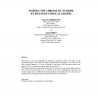154
click to vote
DAM
2011
14 years 7 months ago
2011
An arc of a graph is an oriented edge and a 3-arc is a 4-tuple (v, u, x, y) of vertices such that both (v, u, x) and (u, x, y) are paths of length two. The 3-arc graph of a graph ...
134
Voted
ALGORITHMICA
2010
14 years 10 months ago
2010
The problem of computing the chromatic number of a P5-free graph (a graph which contains no path on 5 vertices as an induced subgraph) is known to be NP-hard. However, we show tha...
125
click to vote
MP
2010
14 years 10 months ago
2010
The Lov´asz theta number of a graph G can be viewed as a semidefinite programming relaxation of the stability number of G. It has recently been shown that a copositive strengthe...
127
click to vote
JGT
2010
14 years 10 months ago
2010
In 1966 Erd˝os and Hajnal proved that the chromatic number of graphs whose
109
click to vote
JGT
2010
14 years 10 months ago
2010
Hadwiger’s conjecture states that every graph with chromatic number χ has a clique minor of size χ. In this paper we prove a weakened version of this conjecture for the class ...
119
Voted
DM
1998
15 years 1 days ago
1998
Suppose G is a graph. The chromatic Ramsey number rc(G) of G is the least integer m such that there exists a graph F of chromatic number m for which the following is true: For any...
125
click to vote
DM
2002
15 years 5 days ago
2002
A simple characterization of the 3, 4, or 5-colorable Eulerian triangulations of the projective plane is given. Key words: Projective plane, triangulation, coloring, Eulerian grap...
151
click to vote
ENDM
2000
15 years 5 days ago
2000
We propose a new exact algorithm for finding the chromatic number of a graph G. The algorithm attempts to determine the smallest possible induced subgraph G' of G which has t...
124
Voted
DM
2000
15 years 5 days ago
2000
Erdos proved that there are graphs with arbitrarily large girth and chromatic number. We study the extension of this for generalized chromatic numbers. Generalized graph coloring d...
116
Voted
ARSCOM
2004
15 years 7 days ago
2004
The concept of circular chromatic number of graphs was introduced by Vince(1988). In this paper we define circular chromatic number of uniform hypergraphs and study their basic pr...

